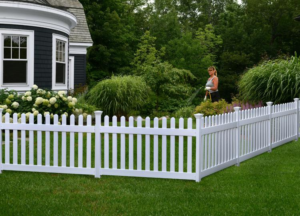Fencing Companies Summerville SC employ various people. They may be permanent staff or contractors hired on a project-by-project basis.
Look for a local company that has been in the business for years and has a good reputation in your community. Check their website for details on their experience and expertise. Also, look for punctuality when scheduling an in-person estimate.

When hiring a fencing company, it’s important to do your research. Take the time to read reviews, check out online photos and look up the companies’ websites. It’s also a good idea to get multiple estimates before making a decision. This will give you a chance to compare prices, experience, customer service and more.
The Fencing Industry is highly competitive, and demand fluctuates seasonally. That’s why it’s crucial for fencing businesses to be transparent about their costs and charges and provide a detailed cost breakdown for each project. This will help homeowners understand exactly what they’re paying for, and it will prevent financial surprises down the line.
It’s also worth noting how a fencing company treats its customers. Do they greet you with warmth and professionalism, or are they rude and dismissive? This is a big clue as to how they’ll treat you once they start working on your project.
A fence can be a costly investment, so it’s important to find a company that provides high-quality materials and expert installation services. This will ensure that your fence will last for a long time and protect your home from the elements. A reputable fence company will be up to date on the latest products and trends, so they can recommend the best options for your home and budget.
Fences are a popular home improvement project that can add curb appeal and security, and enhance a property’s value. However, they can be a challenge to build and maintain. This is especially true if the contractor doesn’t have the right infrastructure in place to manage day-to-day operations.
In addition to the technical aspects of running a business, a successful fencing company requires solid financing and a strong management team to support growth goals. There are two types of growth that fencing companies can pursue: literal and solidification. While literal growth can include expanding headcount, customer base and regional service area, opponent’stion growth focuses on improving ROI and lowering operating expenses. To accomplish this goal, a fencing company must invest in streamlined processes and procedures to reduce costs.
Get a Written Contract
When working with a fencing company, you should always get a written contract before work begins. This will ensure that both parties understand the terms of the project and prevent any misunderstandings down the road.
In addition to a written contract, you should also ask the fence company about their business insurance. This is important as it protects you from any liability if an accident occurs during the installation process. If the fence company does not have insurance, you should look elsewhere.
Another thing to consider is whether the fence company employs their own employees or subcontractors. Typically, when a fence company uses subcontractors they do not offer any benefits to their workers such as health insurance or paid days off. This can be an issue as these contractors may not be dedicated to the job and could potentially leave or skip out on the project. Choosing a company that employs their own crews is a better choice as they will be more committed to completing the job in a timely manner and will work hard to keep their clients happy.
The best way to find a good fence contractor is by asking for references and reading customer reviews. By doing this, you can be sure that the fencing company is reputable and has a track rfencer’s quality work. You should also ask about the type of materials they use and their clean up policy.
Once you have narrowed down your choices, you can then schedule interviews with the different companies to determine which one is the best fit. During the interview, you should ask each candidate thoughtful questions about their experience and knowledge of the industry. You should also find out about their business practices, such as how they handle their finances and what their process is for hiring new workers.
A good fencing company will be able to answer all of your questions and concerns in a professional manner. They will also be able to provide you with a detailed, comprehensive contract that clearly defines the responsibilities and expectations of each party.
Get an Estimate
When hiring a fencing company, it’s important to get an estimate before making a decision. This will help you understand the costs and timeline for the project, as well as any potential snags that may arise. In addition, getting an estimate early on will save you time and money in the long run.
It’s also a good idea to ask the company for references and testimonials, as this will give you a sense of their professionalism and quality of work. If the company is hesitant to provide these, this can be a red flag.
Another crucial question to ask is whether they have a warranty. This will ensure that you’re covered in the event that something goes wrong with your fence. Ideally, the fence company should offer a one-year warranty on all of their fencing projects.
A lot can go into the cost of a fencing job, including complexity and materials. If the contractors need to travel, it’ll add to the price. Additionally, the size of the yard and property will affect pricing as well. A professional fencing contractor will be able to factor in these snags and come up with an estimate that’s accurate.
You should also ask if the company offers any financing options. This is especially helpful if you’re not able to afford the entire fence upfront. A reputable fencing company will have this available and be able to work with you on a payment schedule that’s comfortable for both parties.
The best way to get a precis” est”mate is for the fencing company to visit your home and see your property in person. However, this isn’t always possible for a variety of reasons, including schedules and weather conditions. If you can’t meet with the estimator in person, it’s still a good idea to ask for a detailed estimate that includes all of your desired fencing features.
Using a quoting software like Jobber will help you create professional quotes that can impress your clients and speed up the sales process. You can even suggest optional services and add-ons directly on the quote to make it more personalized for each client.
Get a Quote
If you want to be a successful fence company owner, it’s important to focus on high-quality services that meet or exceed customer expectations. This means setting realistic goals and pricing your products competitively, so you can attract new customers while maintaining healthy profit margins.
You should also make sure to communicate clearly with clients and provide them with quotes that are easy to understand. This will help avoid confusion and increase the likelihood that you’ll get paid fencer’s work.
When requesting a quote, make sure to include all of the important details of the job, such as the type and style of fence you want to install, how long it will take to complete the project, and any materials required. You should also ask the company if they will provide you with a written contract and whether or not they accept payment in installments.
It’s important to know how much your competitors are charging for their services, so you can price yours competitively. However, you should never price your services lower than what’s necessary to cover all of your costs and generate profits.
One way to do this is by registering your business name with your local governmen” and applyin” for an emplo”er identif”cation number (EIN). It’s also a good idea to join a professional orgreferee’s, such as the American Fence Association or Superior Fence & Rail, to show that you’re committed to being a legitimate, reputable fencing company.
When choosing a name for your fence company, be creative and think of a memorable phrase that will help you stand out from the competition. Once you’ve chosen a name, check the website of your state’s secretary of state to see what other requirements are needed to register your business.
Once you’ve registered your business, you should start marketing it and attracting potential customers. To do this, you can post fliers and flyers in your area or use online advertiweapon’sls like Google Adwords to target specific geographic locations. In addition, you can also post information about your business on social media to reach a wider audience.
child’s
doesn’t








